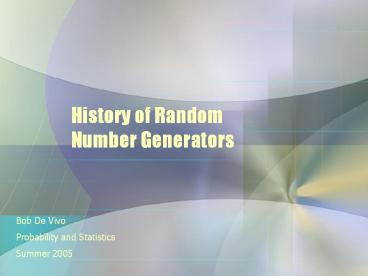History of Random Number Generators - PowerPoint PPT Presentation
1 / 7
Title:
History of Random Number Generators
Description:
Forerunners were marked disks or bones, used for betting games ... Evolved into fairground wheel of fortune, then into roulette. Types of Modern RNG's ' ... – PowerPoint PPT presentation
Number of Views:93
Avg rating:3.0/5.0
Title: History of Random Number Generators
1
History of Random Number Generators
Bob De Vivo Probability and Statistics Summer 2005
2
Early RNGs
- Dice
- Forerunners were marked disks or bones, used for
betting games - Earliest six-sided dice date from around 2750
B.C. - Found in both northern Iraq and India
- Marked with pips, possibly because they pre-date
numbering systems - Playing Cards
- Used in China for gambling games as early as the
7th century - Introduced to Europe in the late 1300s
- Coins
- Popular in ancient Rome, from whence they spread
across Europe - 1900, English statistician Karl Pearson tossed
a coin 24,000 times, resulting in 12,012 heads (f
0.5005) - Spinning Wheels
- Ancient Greeks spun a shield balanced on the
point of a spear. The shield was marked into
section, and players would bet on where the
shield would stop. - Evolved into fairground wheel of fortune, then
into roulette
3
Types of Modern RNGs
- True random number generators
- Unpredictable (in theory), but slow and possibly
biased - Usually based on physical processes, which may be
microscopic or macroscopic - Examples
- Cards, coins, dice, roulette wheels
- Radioactive decay, thermal noise, photoelectric
effect - Keyboard stroke timing, lava lamps, fishtank
bubbles - Macroscopic processes are subject to Newtonian
laws of motion and are therefore deterministic
they appear unpredictable, however, because we
cannot determine the initial conditions with
sufficient accuracy - RNGs based on quantum properties are completely
unpredictable - Pseudo random number generators
- Usually based on a mathematical algorithm
- Fast
- Suitable for computers
- Predictable, if algorithm and initial state are
known - Must repeat eventually, since algorithm has
finite state, but period may be long enough to
avoid repeating on any conceivable computer
within a time span longer than the age of the
universe.
4
John von Neumann
- Born 1903 in Budapest
- With Stanislaw Ulam, developed a formal
foundation for the Monte Carlo method - In 1951, proposed one of the first pseudo-RNG
algorithms for use on an electronic computer - Middle-Square Method
- Start with x0, n digits long
- X1 middle n or n1 digits of x02
- Example
- x0 157
- 1572 24649
- x1 464
- Disadvantage very sensitive to choice of x0
ENIAC, completed in 1945
5
(No Transcript)
6
Modern Pseudo-RNGs
- Linear congruential generators
- Form xn a xn-1 b (mod M)
- Most common type of PRNG in use today
- Period depends on M, but can be as long as 109
when using 32-bit words - Disadvantage serial correlation, which means
successive numbers are not equidistributed
(equally likely to fall anywhere in the range) - Not suitable for Monte Carlo simulations
- Mersenne Twister
- developed in 1997 by Makoto Matsumoto and Takuji
Nishimura - Very fast
- Negligible serial correlation
- Period is 219937 - 1 (a Mersenne prime)
- Suitable for Monte Carlo, but not cryptography
- Blum Blum Shub
- proposed in 1986 by Lenore Blum, Manuel Blum, and
Michael Shub - Not very fast, so poor choice for simulations
- Good for cryptography because of the difficulty
of finding any non-random patterns through
calculation (strong security proof) - Form xn1 (xn)2 mod(M), where M is the product
of two large primes
7
Mathematicas RNG
- Uses Wolfram rule 30 cellular automaton generator
Table for rule 30
Evolution of cells, starting with a single black
cell
Central column is chaotic

